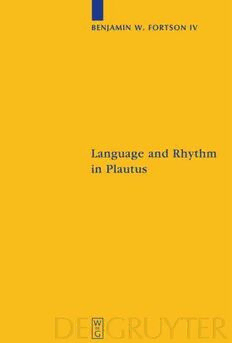
Language and Rhythm in Plautus: Synchronic and Diachronic Studies PDF
Preview Language and Rhythm in Plautus: Synchronic and Diachronic Studies
Benjamin W.Fortson IV Language and Rhythm in Plautus ≥ Sozomena Studies in the Recovery of Ancient Texts Edited on behalf of the Herculaneum Society by Alessandro Barchiesi, Robert Fowler, Dirk Obbink and Nigel Wilson Vol. 3 Walter de Gruyter · Berlin · New York Benjamin W. Fortson IV Language and Rhythm in Plautus Synchronic and Diachronic Studies Walter de Gruyter · Berlin · New York (cid:2)(cid:2)Printedonacid-freepaperwhichfallswithintheguidelines oftheANSItoensurepermanenceanddurability. ISBN 978-3-11-020593-0 BibliographicinformationpublishedbytheDeutscheNationalbibliothek TheDeutscheNationalbibliothekliststhispublicationintheDeutsche Nationalbibliografie;detailedbibliographicdataareavailableintheInternet athttp://dnb.d-nb.de. (cid:2)Copyright2008byWalterdeGruyterGmbH&Co.KG,D-10785Berlin. Allrightsreserved,includingthoseoftranslationintoforeignlanguages.Nopartofthis book may be reproduced or transmitted in any form or by any means, electronic or mechanical, including photocopy, recording, or any information storage and retrieval system,withoutpermissioninwritingfromthepublisher. PrintedinGermany Printingandbinding:Hubert&Co.GmbH&Co.KG,Göttingen. Coverdesign:ChristopherSchneider,Berlin. Contents Preface and Acknowledgments ................................ VII Abbreviations and Symbols ................................... XI Chapter One: Preliminaries................................... 1 Chapter Two: Plautine Iambo-Trochaics ........................ 20 Chapter Three: The Linguistic Background of Luchs(cid:2)s Law ....... 34 Chapter Four: Meyer(cid:2)s and Jacobsohn(cid:2)s Laws ................... 54 Chapter Five: Enjambement .................................. 98 Chapter Six: The Aphaeresis of Est............................ 134 Chapter Seven: Breuis Breuians I ............................. 176 Chapter Eight: Breuis Breuians II ............................. 217 ChapterNine:TowardsaReconstructionoftheProsodyofPlautine Latin Speech ............................................ 259 Bibliography ................................................ 271 Index Locorum ............................................. 289 Preface and Acknowledgments It has been slightly over a decade since I wrote the original version of these studies as my doctoral thesis, Studies in the Prosody of Plautine Latin (Harvard, 1996). The intervening years required not only consid- eration of a good deal of new secondary literature but also many substantial changes over several drafts—in the end more than enough to justifyanewtitle.Mostofmyoriginalconclusionshaveremainedasthey were, but many sections both long and short have been partly or completely reworked, scrapped, or added, and the argumentation throughout has been revised, updated, and tightened wherever possible. The longer chapters were split up to accommodate the numerous additions; the bulk of Ch.8 is entirely new. So as not to reinvent the wheelentirely,Ihadtobeselectiveinwhatmaterialtorevise;hopefully, thefact thatthe resultant bookwasnot written ineinem Zughasnotled to too many inconsistencies in style or content. I must first thank Andrew Dyke for initially spurring me to publish this work and for the many helpful comments and suggestions he made from his reading of the then unrevised thesis. Brent Vine also read through the unrevised work with his customary care and insightfulness, allowingmetoimprovethediscussion ofmanypartsofitand,bydintof his own enthusiastic support, renewing my desire to wrangle with some issuesthat Ihadessentially givenuptryingtosolve.(Istillmaynothave solved them all,but atleast Ibelievethe bookis better asa result ofthe renewed wrangling.) More recently, Mark Hale read through the antepenultimate draft and suggested a number of important improve- ments especially in my reasoning and argumentation, and commented extensively on many sections. My greatestdebtof gratitude, though,goes toLucio Ceccarelli, who, withouthavingpreviouslymademyacquaintance,verykindlyacquiesced to my request to read the same draft and subject it to his metrician(cid:2)s careful eye. He generated dozens of pages of invaluable commentary, savedmefrom countless errors,anddirectedmetoimportant works and views in the metrical literature that I had overlooked or not considered carefully enough. I take this opportunity to express global thanks for his exhaustive input, most of which is reflected in one way or another in the VIII PrefaceandAcknowledgments final product. I trust he will forgive me if some of the more minor of his contributionshavebeenincorporatedsilently,iffornootherreasonthan to lower the number of distracting footnotes acknowledging him. Needless to say, neither he nor my other colleagues are to be held responsible for the work(cid:2)s shortcomings, and they do not necessarily agreewithallmyapproachesorclaims.1Imustrelyonthesharpeyesand minds of my readers to identify (and perhaps solve) the remaining problems. ForhelpwithindividualissuesscatteredthroughoutIamadditionally indebted to the participants at several conferences and other settings where some sections of the work were presented in earlier form. Dirk Obbink receives my gratitude for inviting me to publish this book in the new series Sozomena, and I am indebted both to him and to Dr. Sabine Vogtforsoablyseeingitthroughtheeditorialandproductionprocessat de Gruyter. Thefinalresearchandwritingwerecompletedduringayearspentin Halle an der Saale as a visiting research associate at the Seminar f(cid:3)r Indogermanistik und Allgemeine Sprachwissenschaft, Martin-Luther- Universit(cid:4)t. This research stay was made possible through a generous fellowship administered by the Alexander von Humboldt-Stiftung, supplemented by a Horace G. Rackham Travel Fellowship and Faculty FellowshipEnhancementAwardbestowedbytheUniversityofMichigan. Iwouldlike tothanktheheadofthe Seminar,Prof.Gerhard Meiser,for so graciously hosting me and for affording me access to all the facilities thatIneededattheuniversity.MycolleaguesOlavHacksteinandSabine H(cid:4)usler were also invaluable in numberless ways, both scholarly and practical, prior to my arrival and during my completion of this project. My stay in Halle additionally would not have been possible without the aid of Richard Janko, Brent Vine, and my erstwhile dissertation director Calvert Watkins, for whose efforts and support I remain deeply appreciative. Finally, the fact that my family—Kelly, Christopher, and Halle-born Cecilia—could be with me in Germany made the time spent completing this book all the more enjoyable. 1 DuringmywritingoftheoriginaldissertationIwasaidedgreatlybydiscussions with A. S. Gratwick during the semester that he was in residence at Harvard. Regrettably he was unable to comment on the revised work, so some of the views that he imparted to me a decade ago and that I still cite in this revision maynotreflecthiscurrentthinking. PrefaceandAcknowledgments IX Plautus wrote to make us laugh, and he might well have found it funny that generations of scholars have sweated blood trying to under- stand the workings of his numeri innumeri. Without those luminaries, both past and present, this book could never have been imagined. I may depart from some or all of them at times, but there is little of which I stand in greater awe than their dedication to and insightfulness in unraveling the mysteries of this one Roman author(cid:2)s art. I hope this modest contribution is worthy of their imposing company. But long beforeIhadeverheardofthelikesofBentley,Ritschl,andLindsaycame another sine quo non, Raymond R. Fitzgerald, now S.J., who taught me my first Latin in grade school and inspired me to do what I do now. To him this book is most gratefully dedicated. Ben Fortson Halle an der Saale, July 2007
